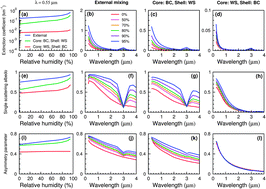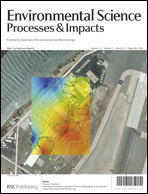Aerosol optical properties of external and core–shell mixtures of aerosol species present in the atmosphere are calculated in this study for different relative humidities. Core–shell Mie calculations are performed using the values of radii, refractive indices and densities of aerosol species that act as core and shell, and the core–shell radius ratio. The single scattering albedo (SSA) is higher when the absorbing species (black carbon, BC) is the core, while for a sulfate core SSA does not vary significantly as the BC in the shell dominates the absorption. Absorption gets enhanced in core–shell mixing of absorbing and scattering aerosols when compared to their external mixture. Thus, SSA is significantly lower for a core–shell mixture than their external mixture. SSA is more sensitive to core–shell ratio than mode radius when BC is the core. The extinction coefficient, SSA and asymmetry parameter are higher for external mixing when compared to BC (core)–water soluble aerosol (shell), and water soluble aerosol (core)–BC (shell) mixtures in the relative humidity range of 0 to 90%. Spectral SSA exhibits the behaviour of the species which acts as a shell in core–shell mixing. The asymmetry parameter for an external mixture of water soluble aerosol and BC is higher than BC (core)–water soluble aerosol (shell) mixing and increases as function of relative humidity. The asymmetry parameter for the water soluble aerosol (core)–BC (shell) is independent of relative humidity as BC is hydrophobic. The asymmetry parameter of the core–shell mixture decreases when BC aerosols are involved in mixing, as the asymmetry parameter of BC is lower. Aerosol optical depth (AOD) of core–shell mixtures increases at a higher rate when the relative humidity exceeds 70% in continental clean and urban aerosol models, whereas AOD remains the same when the relative humidity exceeds 50% in maritime aerosol models. The SSA for continental aerosols varies for core–shell mixing of water soluble aerosol (core)–shell (BC) when compared to their external mixture, while the SSA for maritime aerosols does not vary significantly for different mixing scenarios because of the dominance of sea salt aerosols. Thus, these results confirm that aerosol mixing can modify the physical and optical characteristics of aerosols, which vary as a function of relative humidity. These calculations will be useful in parameterising the effect of core–shell vs. external mixing of aerosols in global climate models, and in the evaluation of aerosol radiative effects.

You have access to this article
 Please wait while we load your content...
Something went wrong. Try again?
Please wait while we load your content...
Something went wrong. Try again?


 Please wait while we load your content...
Please wait while we load your content...